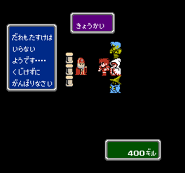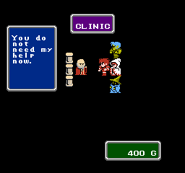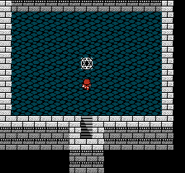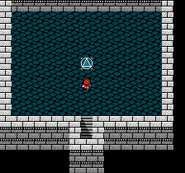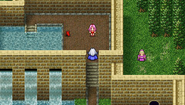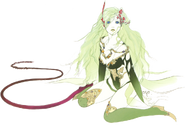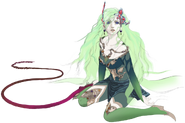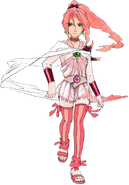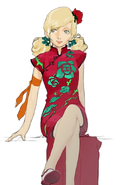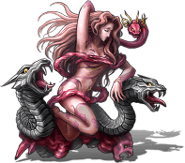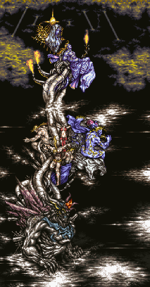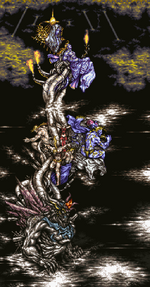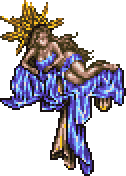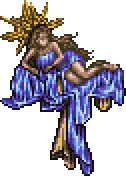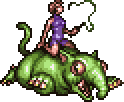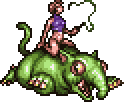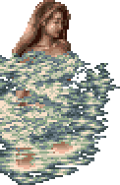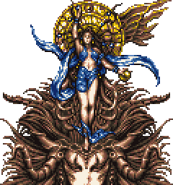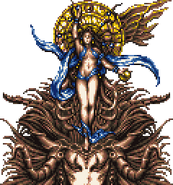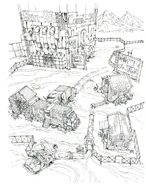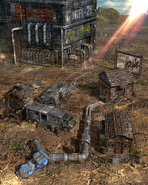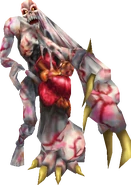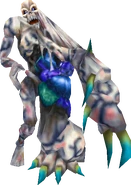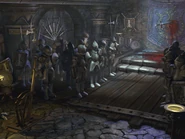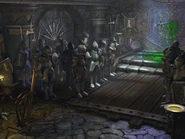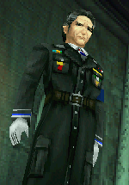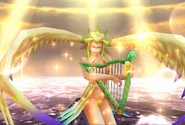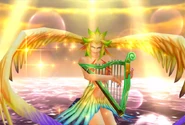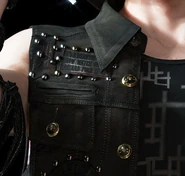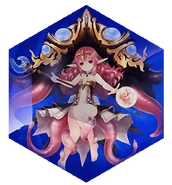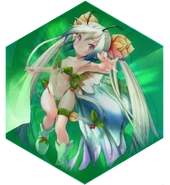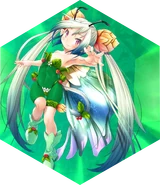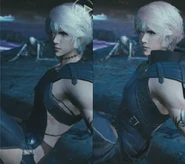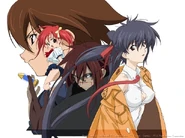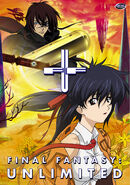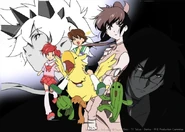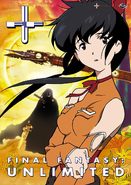Template:Sideicon

A "censor" screen added for humor when using Devour in Final Fantasy VIII.
Censorship refers to the suppression of material that may be considered objectionable, harmful, sensitive, politically incorrect or inconvenient as determined by governments, media outlets, authorities or other groups or institutions. In video games, things are sometimes censored due to ratings concerns. The Final Fantasy series games have seen some changes from their original versions due to sensitivities towards profanity, religious imagery, sexual imagery and violence and gory content.
Appearances
Final Fantasy
The 1990 North American localization was essentially identical to the original Japanese game. However, technical limitations, and the censorship policies of Nintendo of America, resulted in a few minor changes to certain elements. Nintendo of America policy prohibited games from featuring any overt Judeo-Christian imagery or reference to death. Some graphics were modified so that, for instance, churches—renamed "clinics"—no longer featured crosses. This is also probably why the Kill spell was renamed as "Rub".
In the original Japanese Famicom version, the Medusa and Earth Medusa are topless. This was changed for the American localization.
Final Fantasy II
Following the successful release of the original Final Fantasy by Nintendo in 1990, Square Soft, Square's North American subsidiary, began work on an English language localization of Final Fantasy II. Although a beta version was produced, and the game was advertised in several Square Soft trade publications, the age of the original Japanese game and the arrival of the Super Nintendo Entertainment System, the NES's successor console, led Square Soft to cancel work on the Final Fantasy II localization in favor of the recently released Final Fantasy IV (which, to avoid confusing North American gamers, was retitled Final Fantasy II).
Even at the prototype stage changes had been made from the original version due to the religious imagery policies Nintendo had at the time: the Star of David used in a dungeon design was replaced with a triangle, and the cross that replaces a character's face on the pause screen at death was replaced with a gravestone.
Final Fantasy IV
In one cutscene in the original version, Rosa is rescued at the last moment from being executed by a giant scythe. The scythe was replaced with a giant metal ball in the North American version. Religious imagery was removed, such as "Holy" being renamed "White" (though one use of the word "Holy" was still present when the Elder of Mysidia instructs Cecil on how to be a Paladin). The Tower of Prayers in Mysidia was renamed the Tower of Wishes (though one instance of "pray" was still left in, uttered by the Black Mage in the tower). Textual edits removed references to death and violence, partially to adhere to Nintendo's family friendly content guidelines.
In the original Japanese SNES release, the dancing girl that appears in pubs removes her red dress to reveal a bikini underneath before dancing and getting dressed again. The segment of her undressing was removed from the North American and Easy Type releases. It can be seen in the PlayStation release, but is censored again in the Game Boy Advance and PlayStation Portable versions for North America and Europe.
Final Fantasy IV: The After Years
The artworks of Rydia, Porom, and Ursula have been altered to be less revealing for the overseas releases.
Final Fantasy V
The sprite of the boss Melusine was changed for the remastered version, depicting her with the less revealing clothes seen in Amano's artwork .
.
Final Fantasy VI
In the original North American SNES version the spell Holy was renamed "Pearl", the summon "Jihad" was renamed to "Crusader", and Hell's Rider to "Rider". Many sprites were also censored. Overly revealing sprites, such as Siren, Lakshmi (Starlet), Alluring Rider (Critic), Chadarnook (woman), Goddess, Power (Hit), Magic, Lady (Girl), and another untargettable part on the final boss, were censored. The smoke for Misty and her palette-swaps was removed. Pub signs were changed to cafe signs.
The PlayStation version uses all uncensored sprites from the original Japanese release. Siren sprite was re-censored in the localized GBA versions, but not as much as in the SNES release. Chadarnook Goddess sprite was also re-censored for the localized GBA, censoring the same areas but is not the same as the SNES sprite.
Kefka's line when the party flees from him on chocobos was changed. In the Japanese version he says "ヒーーーー くっそ! このかりは必ず返しますよ!", literally translated to "Arggg.... you scums! I will definitely pay you back for this!". In the overseas release, depending on the version, he either says "Son of a submariner! They'll pay for this..." (SNES/PSX version) or "Son of a sandworm! You'll pay for this..." (GBA/PC/iOS).
During the scene where Locke sees Celes imprisoned in South Figaro, she is no longer being beaten by the guards in the GBA version, and they merely taunt her. The censoring of Celes's beating isn't from the localization; this is also present in the Japanese GBA version. The scene where Celes is being tortured by the Gestahlian Empire was removed because the original Final Fantasy VI was created before the Japanese ratings board, CERO, existed. Violence is rated strictly in Japan, and Square wanted a CERO A rating for the Game Boy Advance version, which would have been impossible if a game depicts violence against a restrained human.[1]
The conversation between Edgar and Relm during their first meeting in Thamasa was changed. In the Japanese version, after Edgar learned about Relm's age (10), he said to himself: "I need to get a hold of myself... or it's going to be a crime". In the English versions, Edgar says: "Not even a lady yet. Here's hoping you're still around in eight years, kid". In the Japanese versions, Relm used harsh language, especially for someone her age. The overseas versions toned down the dialogue so that, while still biting, her words are overall clean.
Final Fantasy VII
The concept art for Corel Prison shows the billboard for Shinra Electric Power Company spray-painted over with the word "Fuck". In the final game, the word is further painted over turning it into "Pyck". The brothel Honey Bee Inn initially had more content, but these were removed early, their remains only existing as dummied content in the original Japanese version.
Cloud Strife, Cid Highwind and Barret Wallace's use of the word "shit" and Tifa Lockhart's use of the word "Wench" was censored for the PC version, turning it into symbols, although one instance of it was missed: if the player examines the blue lights in the Forgotten City with Cid as party leader, his reaction still uses the word even in the PC versions.
Crisis Core -Final Fantasy VII-
In the Japanese version, the "Minerva Statue" in the Banora Underground resembles depictions of the Virgin Mary. The statue was likely redesigned for overseas releases to reduce ties to Christianity.
Final Fantasy VIII
In the original Japanese version, the boss Gerogero's organs were red. The change to blue for the localized versions was probably made because the red makes the organs protruding from the creature look more realistic. The red version of Gerogero can also be seen in both the BradyGames and Piggyback Interactive official strategy guides for Final Fantasy VIII.
The Ultimecia Castle's armory originally had red blood on the wall, but in the localized versions it has turned green.
The weapon Selphie wields is called nunchaku in the NTSC versions and "shinobou" in the English PAL version, due to nunchaku's status as an illegal weapon in the UK. The Scan spell can be used to rotate the enemy or teammate in 360 degrees, except for Selphie (likely for modesty reasons).
Caraway originally has a red armband in the Japanese versions, but this is changed to blue in overseas versions to avoid association with Nazi uniforms.[2]
Siren has a feathered sarong in Final Fantasy VIII Remastered. The change is likely due to CERO regulations, as the Remastered could not use the old rating granted for the Ultimate Hits version back when the ratings board was first established. As depictions of nudity (e.g. expression of genitals and parts thereof) have become banned as part of the board's code of ethics,[3] Siren's nudity needed to be toned down. Siren's Triple Triad card still uses the original model, however.
When the player uses the Devour command they get a "Censored...please stand by" message while eating sounds play on the background. Nothing is actually censored; the scene is in every version and is included for humor.
Final Fantasy XII

The scene where Penelo is held hostage is censored from the Japanese version.
The scene where Penelo is tied up in Ba'Gamnan's Lhusu Mines hideout was cut from the original Japanese version to get a lower rating. Producer Akitoshi Kawazu has explained the decision to do this thusly: "[...] at the time right before the Japanese release there were various incidents in the real world which...basically there were some similarities there that would have made it a difficult thing to release at the lower age rating that we wanted."[4]
This is a rare case of a Final Fantasy game being censored for Japan, but not for overseas versions. The "incidents in the real world" Kawazu refers to, but does not specify, may refer to Tsutomu Miyazaki, a Japanese serial killer who abducted and murdered four young girls in Saitama and Tokyo Prefectures from August 1988 to June 1989. His death sentence was upheld by the Japanese supreme court in January 2006, two months before Final Fantasy XII came out. The scene has been included in all Japanese releases since the International Zodiac Job System version.
Final Fantasy XIV
Haurchefant Greystone's personality is different in the English, French, and German versions. According to John Crow, the English localization lead, Haurchefant is intended to be received as a good and true ally, but some of his comments directed at the player could—if rendered in English as written in Japanese—provoke a negative reaction. This wasn't a concern for the Japanese version, as Haurchefant's characterization played to the Japanese archetype of a "lovable debauchee."[5] In the Japanese version, regardless of player character gender, Haurchefant makes comments that may be perceived by a western audience as sexual harassment, greeting players with "Have you come to show me the development of your chiseled body?" and ending conversations with, "...but this area has become increasingly cold, hasn't it? A warm bed will be waiting for you!"
Final Fantasy XV
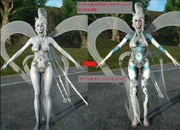
Comparison of the Shiva models.
The Chinese version has an altered model for Shiva with a skin-tight shiny outfit rather than appearing almost nude, and less pale skin. Skeletons and liches were also altered for the Chinese version.
Early material for Final Fantasy Versus XIII had the kingdom of Lucis worship the Grim Reaper more prominently. This was toned down when the game became Final Fantasy XV due to ratings concerns in certain countries.
Prompto Argentum's vest had a tag that read "It's a beautiful day now watch some bastard fuck it up" in the earlier renders for his character, and in the Final Fantasy XV Episode Duscae demo. This is an actual tag available from the clothing company Roen that collaborated to design the main cast's outfits for the game. In the final game the message is changed to "It's a beautiful day now watch some bastard mess it up", although in the Windows Edition it still says "fuck it up" in the highest settings.
The Chadarnook enemy is based on the enemy of the same name from Final Fantasy VI, and is largely similar in appearance as a nude woman with clouds covering her privates. It is the target of a quest from Vyv Dorden, who tasks the party with photographing the famous daemon for his magazine. When he receives the photograph, he remarks that the picture is too risqué for his magazine, lampshading the enemy's previous censorship in VI.
In the bestiary, the 3D models of Shiva, Chadarnook and Melusine are locked from free-rotation, unlike other creature models. In the Dossiers, it is possible to rotate and zoom in on the male characters but not the female ones.
Final Fantasy Type-0
In the HD version, Kazusa's swimsuit model and Emina's lingerie model are removed from the Historical Personae. They were viewable as alternate outfits in the Rubicus after completing the characters' sidequests in the PlayStation Portable version. Female characters' skirts are also more rigid, and less prone to revealing their underwear.
Final Fantasy Tactics
The final battle with Wiegraf Folles is different depending on the version played. Ramza Beoulve and Wiegraf converse numerous times, but a line that is missing in Final Fantasy Tactics: War of the Lions port is Wiegraf stating how religion is perceived in the world in response to Ramza calling him a hypocrite for taking the sides that he has. This was likely removed as it might be offensive to people in the newer version.
Final Fantasy Tactics Advance
In the Japanese version, a scene at the beginning of the game was modified for the English release: the death of his wife, Remedi, caused Cid to fall into a drunk stupor. His depression was downplayed in the English version, where Mewt and his friends catch him cringing before his superiors at work.
Final Fantasy Mystic Quest
The Holy spell was censored to White.
Final Fantasy Adventure
The magic circle in Wendel was a hexagram (Star of David) in the original Japanese version. It was changed to an octagram for the North American and European versions. Sumo and Amanda are looking for Medusa's blood in the Japanese version, not her tears.
The Final Fantasy Legend
God was changed to Creator due to the Video Game Content Guidelines set by Nintendo of America.
Final Fantasy Legend II
On Edo World, the bananas mentioned in the story were originally opium in the Japanese version.
Final Fantasy Legend III
The word Holy was censored to White; this affects the white magic Holy and the Holy Lance. The Holy Swords were renamed to Mystic Swords.
Bravely Default
The western release has been modified with characters' outfits made less revealing and some outfits being completely removed. Some characters have been aged a couple of years compared to the Japanese game. Airy's third boss form is more revealing in the Japanese version.
Bravely Second: End Layer
Aimee Matchlock has a Native American-themed job class and outfit in the Japanese version, but had her job and outfit altered to a cowboy theme in the overseas releases. All playable characters' outfits were restyled to a cowboy theme as well.
Magnolia Arch's Planeswarden Garb has a white line placed through the outfit's slit in the overseas releases. Bonsoir Bunny and Bravo Bunny's stomach cut outs were filled in and the thighs were covered. The Eastern War Garb's bottom half was covered up with a toga.
Many job outfits for Edea Lee and Magnolia have shadows placed around their thighs, regardless of whether "upskirt" views were possible. Magnolia's cleavage is reduced or completely removed for many of her job outfits, including Summoner and White Mage.
The game's artbook as featured in English collector's editions omitted various artworks that were present in its Japanese publication. These artworks are AR card-related images of Agnès bound by red thread (seven are removed, one is edited to remove the red thread), and a bloodied Geist (which features in the game itself). The artbook does not remove other artworks depicting things censored in the game, e.g. Aimee's Native American outfit.
Final Fantasy Dimensions II
The Signet artworks for many female summons have been altered to be less revealing in the localization. Examples include Sylph's default appearance being changed into a leotard and stockings being added to the Mind Flayer summon.
Mobius Final Fantasy
Wol was designed with a lightweight costume for his initial "Onion Knight" gear, seeing that it was intended as a "bare bones" job. In response to player feedback, however, the design was changed to cover up more.[6]
Per announcement in early November 2018, this title no longer operates in Belgium as of November 30, 2018. Uncertainty over gambling mechanics was cited as the reason for withdrawal. Similar rationale was applied to two other games, below.
Dissidia Final Fantasy Opera Omnia

Japanese (left) and Global (right).
One of Kefka's stickers was censored in the global version. The texts in the image of "Chikushou!" (ちくしょう!, damn it!) sticker was changed to "Son of a sub!" However, the game shares the same voice overs with the Japanese version. The Japanese sticker can also be considered censored, since it's not exactly what Kefka said in Final Fantasy VI script (kusso, くっそ). Despite being a foul language, chikushou means "damn it", while kusso has various meanings, including "damn it", "scum", and "shit". The voice actor also voiced this sticker as "Chikushaaaaa!" instead of saying the word directly.
This title is not available in Belgium due to uncertainty regarding the country’s gambling laws and their effects on gacha. Square Enix chose to withdraw Opera Omnia voluntarily in late 2018 as a result.
Final Fantasy Brave Exvius
This title is not available in Belgium due to uncertainty regarding the country's gambling laws. Square Enix and Gumi chose to withdraw Brave Exvius in late 2018.
Final Fantasy: Unlimited
Promotional materials for the North American release censored instances of Lisa Pacifist's nipples visible from beneath her clothing via removing shading and rounding edges. The official ADV DVD show site had a hidden page that showed two uncensored artworks and titled them "Lisa is Chilly", jokingly rationalizing her protruding nipples being a physiological reaction to Wonderland being cold.
References
- ↑ Inside Gaming - Interview with Former Square Enix Translator Tom Slattery (Accessed: June 16, 2018) at RPGamer
- ↑ Q&A for Final Fantasy VIII page 2 (dead) (Accessed: March 02, 2001) at Final Fantasy VIII PlayStation Europe site (dead)
- ↑ Code of Ethics (CERO official homepage) (Accessed: September 07, 2018) at CERO
- ↑ Q&A: Final Fantasy XII producer Akitoshi Kawazu (Accessed: June 16, 2018) at GameSpot
- ↑ Thread: Regarding the Localization of Haurchefant in the EN/FR/DE Versions of FFXIV (Accessed: August 16, 2018) at Official Final Fantasy XIV Forums
- ↑ "Too sexy!" New Final Fantasy's hunky male lead has his revealing costume toned down (Accessed: June 16, 2018) at SoraNews24

